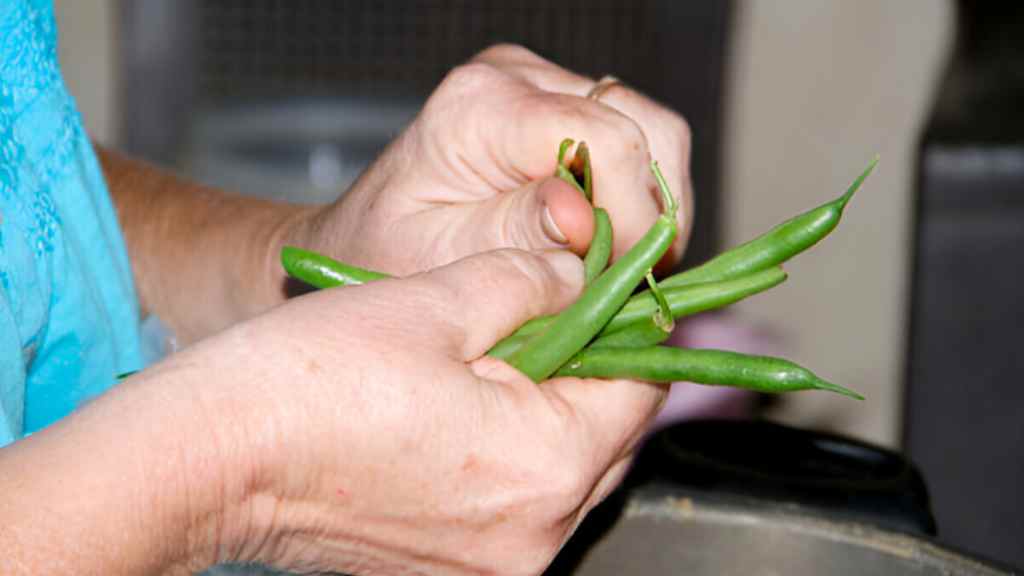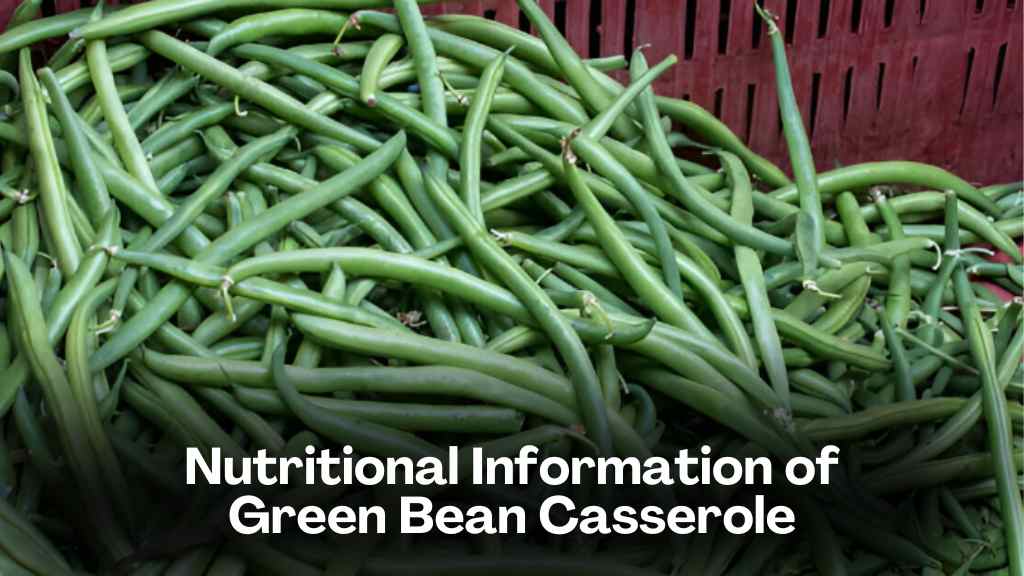Green bean casserole is a beloved dish that graces many holiday tables, particularly during Thanksgiving and Christmas. With its creamy texture, savory flavor, and nostalgic appeal, it’s easy to see why this dish has remained a staple for decades. However, while it’s often enjoyed for its taste, there’s a lot more to this comforting dish than meets the eye. Let’s delve into the nutritional aspects of green bean casserole, explore its health benefits, and discover how you can make it a healthier option without sacrificing flavor.
- Understanding the Ingredients
- Detailed Nutritional Information of Green Bean Casserole
- Can Too Many Green Beans Be Bad for You?
- Making a Healthier Green Bean Casserole
- Do Green Beans Lose Nutrients When Cooked?
- Step-by-Step Guide to a Healthier Green Bean Casserole
- Why Choose This Recipe?
- Try It Out!
- Frequently Asked Questions
Understanding the Ingredients
Before we dive into the nutritional details, let’s take a quick look at the typical ingredients found in a traditional green bean casserole. This dish usually includes:
- Green beans
- Cream of mushroom soup
- Fried onions
- Milk
- Butter
- Seasonings
Each of these ingredients contributes to the overall taste and texture of the casserole. But what about their nutritional impact?
Green Beans: The Nutritional Powerhouse
Green beans are an inexpensive, versatile, and easy-to-find source of healthy carbohydrates, protein, fiber, and micronutrients. They can be grown at home, ensuring you get the freshest produce possible. Let’s look at the nutritional breakdown of green beans, which can provide a better understanding of their benefits.


Nutritional Facts of Green Beans (Per 100g)
- Calories: 31
- Protein: 1.8g
- Carbohydrates: 7g
- Fat: 0.2g
- Fiber: 2.7g
- Sugars: 3.3g
- Vitamin C: 12.2mg
- Vitamin A: 35mcg
- Vitamin K: 43mcg
- Iron: 1mg
- Potassium: 211mg
- Vitamin B6: 0.1mg
- Folate: 33mcg
Green beans are a good source of complex carbohydrates. They provide quick energy with 4g of starch per serving. Additionally, the almost 3g of fiber per serving helps stabilize blood sugar, boost satiety, and improve digestive health. Green beans have a glycemic index (GI) of about 32, making them a low-glycemic food.
Other Ingredients and Their Nutritional Impact
While green beans themselves are quite healthy, other components of the green bean casserole can significantly alter the dish’s nutritional profile.
Cream of Mushroom Soup
Traditional cream of mushroom soup can be high in sodium and fat, particularly saturated fat. This ingredient is often necessary to achieve the creamy texture we love in green bean casserole, but it’s worth considering alternatives or making your own to control the sodium and fat content.
Fried Onions
Fried onions add a delightful crunch to green bean casserole, but they also introduce extra fat and calories. Using a baked version or making them at home can reduce the amount of unhealthy fats.
Milk and Butter
Both milk and butter are standard in green bean casserole recipes, contributing to the creamy texture and rich flavor. Opting for low-fat milk and using less butter or substituting it with olive oil can make a healthier dish without compromising on taste.
Detailed Nutritional Information of Green Bean Casserole
Let’s take a closer look at the nutritional information for a traditional green bean casserole. Here’s what you can expect in a typical serving size of one cup (220g):
- Calories: 191
- Total Fat: 10g (13% Daily Value)
- Saturated Fat: 1.9g (10% Daily Value)
- Polyunsaturated Fat: 5.2g
- Monounsaturated Fat: 2.2g
- Cholesterol: 1.1mg (0% Daily Value)
- Sodium: 932mg (41% Daily Value)
- Total Carbohydrates: 22g (8% Daily Value)
- Dietary Fiber: 3.3g (12% Daily Value)
- Sugars: 2.5g
- Protein: 4.1g
- Vitamin D: 0.3mcg (1% Daily Value)
- Calcium: 73mg (6% Daily Value)
- Iron: 1.5mg (8% Daily Value)
- Potassium: 213.1mg (5% Daily Value)
These values highlight that while green bean casserole can be a nutritious side dish, it is also high in sodium. Given the American Heart Association’s recommendation to limit sodium intake to 2,300 milligrams or less per day, with an ideal limit of 1,500 milligrams for most adults, the sodium content in a single serving of green bean casserole is quite significant.
Can Too Many Green Beans Be Bad for You?
While green beans are undeniably nutritious, offering a wealth of vitamins, minerals, and fiber, it’s essential to remember that moderation is key in any diet. Consuming green beans in large quantities can lead to some digestive issues, such as bloating or gas, due to their high fiber content. Moreover, green beans contain lectins and phytates, compounds that can interfere with nutrient absorption if consumed excessively. However, for most people, enjoying green beans as part of a balanced diet poses no significant risk. It’s all about variety and ensuring that your diet includes a wide range of fruits, vegetables, and other nutrient-dense foods. By doing so, you can enjoy the health benefits of green beans without any adverse effects.
Making a Healthier Green Bean Casserole


If you can’t imagine Thanksgiving without this classic dish, don’t worry! There are many ways to elevate the taste, texture, and nutrition of your green bean casserole without losing the traditional flavor your family loves.
Using Fresh Green Beans
Instead of canned green beans, opt for fresh green beans. This switch not only improves the texture of your dish but also significantly reduces the sodium content. Fresh green beans are crisp and vibrant, providing a better overall eating experience.
Healthy Cooking Methods
Steaming or roasting green beans instead of boiling them can help retain their nutrients. For example, when roasting green beans, simply toss them with a bit of olive oil and your favorite seasonings before placing them in the oven.
Homemade Cream of Mushroom Soup
Making your own cream of mushroom soup is a fantastic way to control the ingredients and reduce the sodium and fat content. Use low-sodium broth, fresh mushrooms, and low-fat milk or Greek yogurt to create a delicious and healthier version of this essential ingredient.
Baked Onions Instead of Fried
Instead of using store-bought fried onions, try baking your own. Slice onions into rings, toss them with a small amount of olive oil, and bake until crispy. This method reduces the fat content and adds a delicious homemade touch to your casserole.
Herbs and Spices
Using herbs and spices is a fantastic way to enhance the flavor of your green bean casserole without adding extra sodium. Garlic, thyme, parsley, and a pinch of nutmeg can elevate the taste of your dish significantly.
Do Green Beans Lose Nutrients When Cooked?
Cooking green beans can cause some nutrient loss, particularly in water-soluble vitamins like vitamin C and B vitamins. However, this doesn’t mean you should avoid cooking them. Certain cooking methods, such as steaming or microwaving, help retain more nutrients compared to boiling. Interestingly, cooking green beans can also make some nutrients, like antioxidants, more available for absorption. For instance, cooking can break down the tough cell walls of the beans, making it easier for your body to access and absorb these beneficial compounds. So, while there might be some nutrient loss, cooking green beans still offers plenty of health benefits and can make them more enjoyable to eat. When considering the Nutritional Information of Green Bean Casserole, it’s essential to understand how cooking methods can impact the nutrient content of green beans.
READ ALSO: Impetigo vs. Hand, Foot, and Mouth Disease: What You Need to Know
Step-by-Step Guide to a Healthier Green Bean Casserole
Here’s a step-by-step guide to making a heart-healthy green bean casserole that doesn’t compromise on flavor:
Ingredients
- 1 sweet onion, cut into rings
- ¼ cup extra-virgin olive oil, divided
- ½ cup all-purpose flour, divided
- ⅓ cup panko breadcrumbs
- 1 tsp garlic powder
- 2 lbs fresh green beans, tough ends removed
- 3 cloves garlic, minced
- 2 cups low-sodium vegetable broth
- 1 cup low-fat (1 percent) milk
- ⅔ cup low-fat plain Greek yogurt
- ¼ cup grated Parmesan cheese
- 2 tbsp fresh parsley, chopped
- 2 tbsp fresh thyme
- ½ tsp kosher salt
- ¼ tsp freshly-ground black pepper
- ⅛ tsp ground nutmeg (optional)
Directions
- Preheat oven to 375°F (190°C). Line 2 baking sheets with parchment paper and set aside.
- Prepare the onions: Place onions in a large mixing bowl. Drizzle with 1 tbsp olive oil and gently toss to coat. Add ¼ cup flour, breadcrumbs, and garlic powder, and toss again. Transfer onions to one of the prepared baking sheets and bake until lightly golden brown, about 20 to 25 minutes, flipping halfway through.
- Roast the green beans: Place green beans on the second prepared baking sheet. Drizzle with 1 tbsp olive oil and toss to evenly coat. Bake until tender-crisp and bright green in color, about 8 to 10 minutes.
- Make the sauce: While the beans roast, place a large skillet over medium heat. Add the remaining 2 tbsp olive oil and ¼ cup flour. Whisk until a paste forms, then add the garlic. Very slowly whisk in broth and cook until the mixture thickens, about 5 minutes.
- Combine and bake: Once the mixture thickens, remove it from the heat. Stir in milk, yogurt, cheese, parsley, thyme, salt, pepper, and nutmeg (if using). Place the green beans in a 9×11-inch baking dish. Top with the sauce and gently stir to coat. Top with the onion mixture and bake in the oven until the sauce is bubbling and the topping is lightly browned, about 25 to 30 minutes. Allow to cool slightly before serving.
Nutritional Information (Per Serving)
- Calories: 155
- Total Fat: 7g
- Saturated Fat: 1.5g
- Protein: 6g
- Carbohydrates: 19g
- Fiber: 3.2g
- Sugars: 6.9g
- Added Sugar: 0.3g
- Sodium: 150mg
This healthier green bean casserole recipe is perfect for those who want to enjoy their favorite holiday dish without compromising on health. It’s heart-healthy, lower in sodium, and made with fresh, wholesome ingredients. Plus, it’s a dish that everyone will love, from the youngest family member to the oldest.
Why Choose This Recipe?
This healthier green bean casserole recipe is perfect for those who want to enjoy their favorite holiday dish without compromising on health. It’s heart-healthy, lower in sodium, and made with fresh, wholesome ingredients. Plus, it’s a dish that everyone will love, from the youngest family member to the oldest.
Try It Out!
Why not try making this healthier green bean casserole for your next family gathering? You might find that this version becomes the new family favorite. With its improved nutritional profile and delightful taste, it’s a win-win for everyone at the table.
Frequently Asked Questions


A true master in his field, Hayate takes the helm as the author of Supreme Hall’s ‘Health’ category. Through his informative and engaging blogs, he shares valuable insights on wellness, fitness, and holistic living, empowering readers to lead healthier and happier lives.


